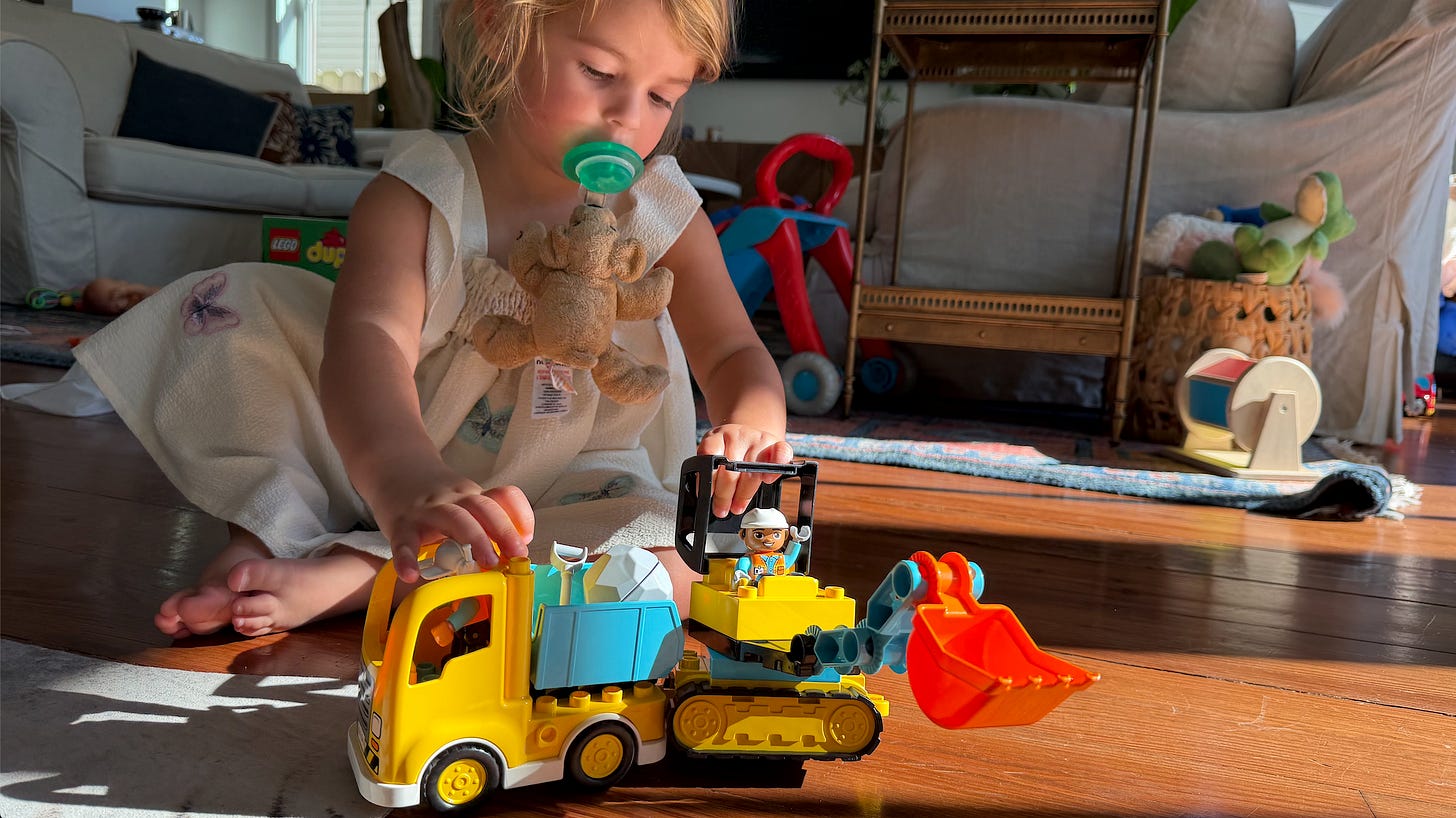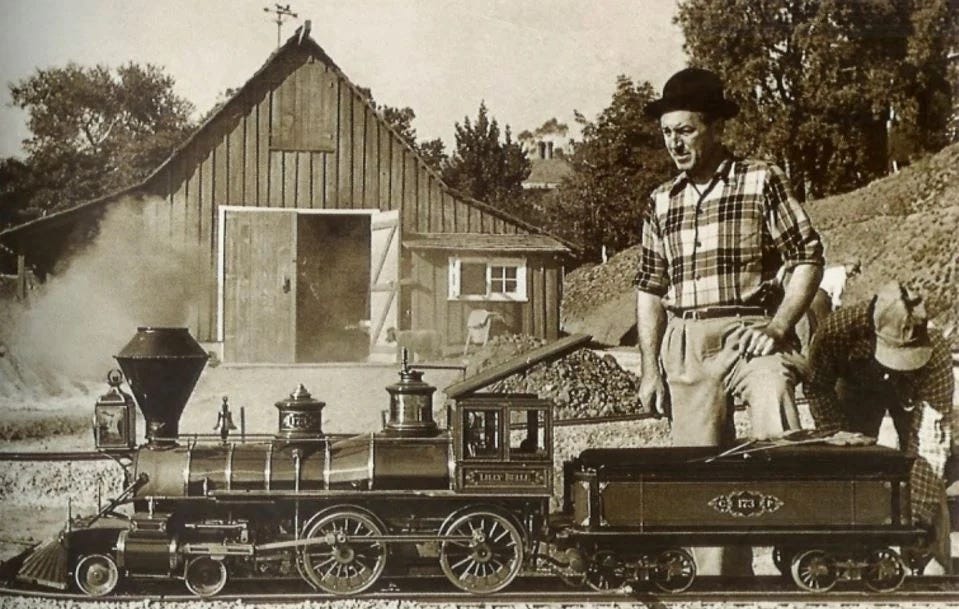🧱 Finding Flow Block by Block
Turning leisure into work and work into leisure.
Welcome to the second #BuilderBlock 🧱, which are small behavioral tools that will help you figure out how to hack your brain into the mindset you need at every stage of the value creation process. I hope you enjoy, and if you do, hit the ❤️ button at the end.
Play Well
“The mind is a wonderful thing, and it’s useful to create things with it.” -Nathan Sawaya, Lego artist
The origin story of Lego has a few similarities as the IKEA story. Founded in a tiny town hours away from civilization in the nordics, it was a simple wood worker that wanted to make a dent on the world. Except, this time, the founder was hit with major tragedy at the origin story -- we’ll see this time and again. Widowed with 4 kids, he devoted his work to helping kids develop. He wanted to build toys that would help them turn into Builders.
Lego technically is a combination of 2 Danish words, “leg godt” which translates to “Play Well.” Ole Kirk Christiansen believed that by stimulating creative play in kids, he was building foundational behavioral tools for their later lives. In the remarkably great business book Brick by Brick, the company’s missions through the years inspire even the most jaded.
“Over the decades, LEGO has refined and reinterpreted its mission: to infuse children with the ‘joy of building, pride of creation’; to ‘stimulate children’s imagination and creativity’; to ‘nurture the child in each of us.’ But on a fundamental level, the company’s goal has stayed remarkably consistent and is probably best expressed in its current iteration: “‘to inspire and develop the builders of tomorrow.’”
In my dad’s toy store growing up, when “straightening” the shelves or taking inventory, I was always most drawn to the Lego shelves. I would lust after the latest set, and imagine all the things I could build with the next iteration of a jungle, space, or arctic edition. What I didn’t realize at the time, is this obsession with the Danish bricks would lead to my brain developing the right hemisphere aptitudes the most.
When in my teens, still playing with Legos like a proper nerd, my parents took me to Houston to test my mental aptitudes, to see where they should aim my educational trajectory. 3D spatial was the highest. The consultants advised a career in architecture or engineering. What we all didn’t realize at the time was 3D spatial is one of the most common proxies for right brain creative visioning. In hindsight, and as a dad, I now try and give Legos or any kind of building toy to my kids nearly every single morning.
(My daughter Sofia playing with her constructors Duplo set)
As nearly every person in the world knows, the joy in Legos is in the building -- not necessarily the outcome. It is the same behavioral hack that Ingvar Kamprad must have realized when he suggested customers build their own furniture. Step by step. Screw by screw, and block by block.
Finding Flow
“Of all the virtues we can learn no trait is more useful, more essential for survival, and more likely to improve the quality of life than the ability to transform adversity into an enjoyable challenge.” -Mihaly Csikszentmihalyi (Flow Pioneer)
And while building things at a young age can help develop your right brain creative and imaging aptitudes, the “killer app” in a Lego kit is the state of flow that it will put you in.
Whenever you are brainstorming, trying to solve a problem, or need to create a new plan of attack, you need a trigger to get your mind in its right-brain non-language speaking segment. This is where insights come from -- often by making connections from random parts. It is non-linear and doesn’t speak language. It’s hard to articulate. The right brain feels, it doesn’t speak.
We can trigger the brain’s state of flow by getting immersed in a task. It could be painting a room, mowing the lawn, playing a game or sport, or working on a 1,000 piece puzzle. For me, I’ve even triggered flow by working on an excel model. Yes, I know that sounds geeky, but basically, you can trigger this part of your brain to kick in through many different activities. The key to flow is a healthy balance between challenge and skill, with immediate feedback that absorbs you in the act.
The key is that task should be relatively basic but sufficiently chalenging. Taking a shower or going on a run is not going to put you in flow -- though many times it can put you in a meditative state, which is the cousin to the process of flow.
You’re not going to trigger flow by creating too much stress for your brain to solve a problem, and you can’t be multi-tasking. In fact, it’s almost the opposite. The more relaxed mental state allows us to consider a problem, a dilemma, or a major task without the input of the language monkey in our head -- which remains occupied with the painting, puzzle or the lawmower. Or.. the Lego set.
(Duplo Builders)
That allows for the subtle, abstract, language free part of our brains to be at the forefront of our conscious awareness. And you can start to feel the solution or the answer to your dilemma before you can articulate it. In my experience, once the feeling has been conceived, even when you’re finished the lawn, the painting, or whatever triggered your state of flow -- your brain will keep working on it until you can articulate it. But the inception is key. Flow is that behavioral hack to inception.
When in a state of flow, you’ll know it -- most probably in hindsight. You become totally immersed in the task. You forget to eat, sometimes you forget to use the restroom. You are lost in time. And that’s actually quite fitting, because the right brain has no sense of past or future -- it’s only in the present.
While modern psychology has yet to agree with this assertion, having experienced it time and again, I feel strongly that the reason why flow is so damn effective is because our left-brains are focused on the task at hand, getting the voice in our head to shut the hell up. That allows us to bring consciousness to our right brain problem-solving and solution-creating selves.
A Lifesaving Hobby
“We keep moving forward, opening new doors and doing new things, because we’re curious … and curiosity keeps leading us down new paths.” -Walt Disney
But don’t take my word for it. Increasingly, psychologists are asking patients with many forms of mental illness to “get a hobby.” This was exactly the prescription Walt Disney used as he was dealing with major depression after a series of setbacks he faced at his studios.
The company went public, and was on a profit treadmill. The animators collectively formed a union and would start striking. And after a series of box office failures, he had more creative constraints on his productions. This was not the studio that he loved in his earlier years. It was left brain organization structures, regulations, administration, and win-lose relationships.
So he started to create small porcelain trains. He would stay up late, painting trains through all hours of the night. In short order, he started to create towns and settings for his trains to live in their own little world -- and then he mechanized the train to start moving on track.
One hobby led to another, and a mere months later, he was laying miniature train tracks in his backyard, and was finding himself with the rare fetish of collecting real steam engines that would be fractions of the normal size. There weren’t a lot of buyers, or sellers, for miniature working steam engines. But he was totally addicted to building trains and creating the landscapes around them.
(Walt with his hobby train)
If you can see where this is going, it’s because you’ve likely been to the “happiest place on earth.”
Walt Disney’s hobby, which allowed his maxi right brain to escape from the left brain world of P&L, unions, and org structures, led him all the way to creating Disneyland -- perhaps his most remarkable achievement of a very storied life.
Not only did Walt credit the train hobby with saving his literal life, bringing him back from the bottom of the ocean depression, it would end up leading to a remarkable breakthrough for amusement parks, his company, and tourism as we know it.
While every major amusement park operator at the time told him his ideas would fail, Walt had seen nearly every detail in his 3D spatial brain. Even the size and placement of the trees. It defied linear logic. It defied the left brain — because it came from the pure right brain creative potential.
In Short
“Hobbies are a contradiction; they take work and turn it into leisure, and take leisure and turn it into work.” — Steven M. Gelber
Before I had kids, I would typically feel guilty immersing myself in a game, project or puzzle on the weekends. But now that I’m committed to daddy duty, often playing with Legos, I’ve seen first hand the creative and strategic benefits to putting yourself in flow.
If nothing else, it’ll make you happier. And that alone is worth the hour or two you spend on your next hobby.
So now that we have a new weekend upon us, do something for yourself and your creative next endeavor - and spend a few hours on a hobby. Whether brick by brick, block by block or brush by brush, you’ll bring yourself back to your most creative self -- the place where wonderful new possibility is born.
The happiest place in your brain.





You have kids!
Loved this article so much, Steven! So looking forward to finding my flow over here in Rome ✨